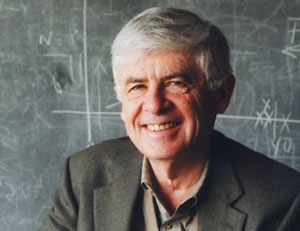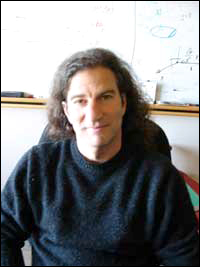Mathematicians awarded prizes for work on fluid mechanics, interface dynamics
Alexandre Chorin and James Sethian, two UC Berkeley and LBNL mathematicians, will receive awards from the world's largest applied mathematics society for their career and pioneer contributions to the field.
September 20, 2010
The world’s largest applied mathematics society, the International Council for Industrial and Applied Mathematics (ICIAM), has awarded two of its five quadrennial prizes to two University of California, Berkeley, and Lawrence Berkeley National Laboratory (LBNL) mathematicians.

Alexandre Chorin (Peg Skorpinski photo)
Alexandre J. Chorin, University Professor of Mathematics and a senior scientist in LBNL’s Mathematics Group, will be honored with the 2011 Lagrange Prize, established “to provide international recognition to individual mathematicians who have made an exceptional contribution to applied mathematics throughout their career.”
James A. Sethian, professor of mathematics at UC Berkeley and head of LBNL’s Mathematics Group, will receive the 2011 Pioneer Prize “for pioneering work introducing applied mathematical methods and scientific computing techniques to an industrial problem area or a new scientific field of applications.”
The prizes, announced Monday, Sept. 20, are awarded every four years, and will be presented at the council’s meeting July 18-22, 2011, in Vancouver, Canada.
Chorin, 72, introduced powerful new computational methods for the solution of problems in fluid mechanics, covering the spectrum from practical software to rigorous error bounds.
His methods are widely used to model airflow over aircraft wings and in turbines and engines, water flow in oceans and lakes, combustion in engines, and blood flow in hearts and veins. His methods have also contributed to the theoretical understanding of turbulent flow.
“Beginning with his pioneering work 40 years ago, Chorin developed some of the key mathematical and algorithmic ideas that underlie many of the most powerful computer codes in computational fluid dynamics,” according to Chorin’s citation from ICIAM. “By performing careful numerical experiments along with theoretical convergence studies, Chorin has placed the numerical solution of complex flow on a solid mathematical foundation for the first time.”

James Sethian
A native of Poland, Chorin graduated from the École Polytechnique Fédérale in Lausanne, Switzerland, and received his M.S. and Ph.D. (1966) from the Courant Institute of New York University. He is a member of the National Academy of Sciences and a fellow of the American Academy of Arts and Sciences. Among his honors is the National Academy of Sciences’ Award in Applied Mathematics and Numerical Analysis and the 2000 Norbert Wiener Prize.
Sethian, 56, introduced mathematical and computational frameworks to track moving interfaces, and has carried these techniques into diverse areas throughout science and engineering.
His methods have been applied to understanding how to manufacture semiconductors, detect anatomical structures in medical images, accurately model combustion processes, improve industrial inkjet printing, and reconstruct geological structures from reflected waves.
“This extraordinary range of successes is made possible by Sethian’s unparalleled eagerness to learn thoroughly the engineering aspects of problems he works on, the accuracy and depth of his feeling for mathematical structure, and his broad mathematical knowledge,” according to his prize citation. “His body of work is emblematic of what an applied mathematician should aspire to achieve.”
Sethian received his B.A. in mathematics from Princeton University in 1976 and earned his Ph.D. in applied mathematics from UC Berkeley in 1982. A member of the mathematics faculty since 1983, he is a member of the National Academy of Engineering and the recipient of the 2004 Norbert Wiener Prize in Applied Mathematics.
ICIAM also awarded the Collatz Prize to Emmanuel J. Candès of Stanford University and Caltech; the Maxwell Prize to Vladimir Rokhlin of Yale University; and the Su Buchin Prize to Edward Lungu of the University of Botswana in Gabarone.
Related information
ICIAM press release